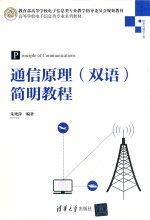图书介绍
通信原理双语简明教程pdf电子书版本下载

- 朱艳萍编著 著
- 出版社: 北京:清华大学出版社
- ISBN:9787302520573
- 出版时间:2019
- 标注页数:210页
- 文件大小:60MB
- 文件页数:224页
- 主题词:通信原理-高等学校-教材-英、汉
PDF下载
下载说明
通信原理双语简明教程PDF格式电子书版下载
下载的文件为RAR压缩包。需要使用解压软件进行解压得到PDF格式图书。建议使用BT下载工具Free Download Manager进行下载,简称FDM(免费,没有广告,支持多平台)。本站资源全部打包为BT种子。所以需要使用专业的BT下载软件进行下载。如 BitComet qBittorrent uTorrent等BT下载工具。迅雷目前由于本站不是热门资源。不推荐使用!后期资源热门了。安装了迅雷也可以迅雷进行下载!
(文件页数 要大于 标注页数,上中下等多册电子书除外)
注意:本站所有压缩包均有解压码: 点击下载压缩包解压工具
图书目录
Chapter 1 Introduction 1
1.1 Basic concepts and models of communication system 2
1.1.1 Communication system model 2
1.1.2 Analog communication model 2
1.1.3 Digital communication model 3
1.2 The classification of communication systems 4
1.2.1 Modulation mode 4
1.2.2 Division of frequency band 5
1.3 Information and its measurement 6
1.4 The main performance index of communication systems 7
Summary and discussion 8
Homework 9
Vocabulary 9
Chapter 2 Random processes 11
2.1 Basic concepts of random processes(Definition of random processes) 12
2.1.1 Definition 12
2.1.2 Numerical characteristics of a random process 13
2.2 Stationary Random Process 14
2.2.1 Definition 14
2.2.2 Ergodicity 15
2.2.3 Autocorrelation function of stationary random processes 17
2.2.4 Power Spectral Density 17
2.3 Gaussian process 19
2.4 Transmission of a random process through a Linear Time-Invariant (LTI)filter 21
2.5 Narrowband random process 23
2.6 Sine wave plus narrowband Gaussian noise 26
2.7 Gaussian white noise and band pass white noise 27
Summary and discussion 29
Homework 30
Vocabulary 31
Chapter 3 Channel 32
3.1 The classification of channels 33
3.1.1 Wireless channels 33
3.1.2 Wire channel 34
3.2 Channel models 35
3.2.1 Modulation channel model(调制解调模型) 35
3.2.2 Coding channel model(编码信道模型) 36
3.3 Influence of the channel characteristics on transmission (for modulation model) 37
3.3.1 Influence of constant parameter channel on signal transmission 37
3.3.2 Influence of random parameter channel of signal transmission 37
3.4 Channel capacity (continuous channel) 40
Summary and discussion 41
Homework 42
Vocabulary and terminologies 42
Chapter 4 Continuous-wave modulation (Analog modulation system) 43
4.1 Introduction 43
4.2 Linear modulation 44
4.2.1 AM 45
4.2.2 Double-Sideband Modulation 46
4.2.3 Single-Sideband Modulation 47
4.2.4 Vestigial Sideband Modulation 49
4.3 Anti-noise performance of linear demodulation 51
4.3.1 Noise in linear receiver using coherent detection 52
4.3.2 Noise in AM receivers using envelope detection 54
Homework (part 1) 57
4.4 Angle modulation (Non-linear modulation process) 58
4.4.1 Basic definitions 58
4.4.2 NBFM(窄带调频) 60
4.4.3 Wide-band frequency modulation (WBFM) 61
4.4.4 Generating an FM signal 62
4.4.5 Demodulation of FM signals 63
4.4.6 Noise in FM receivers 64
4.5 Frequency-division multiplexing(频分复用) 66
Summary and discussion 67
Homework (part 2) 68
Terminologies 68
Chapter 5 Pulse modulation 69
5.1 Sampling process 70
5.2 Analog pulse modulation(模拟脉冲调制) 72
5.3 Quantization process(量化过程)of sampled signal 74
5.3.1 Uniform quantization(均匀量化) 75
5.3.2 Nonuniform quantization 76
5.4 PCM (Pulse code modulation,脉冲编码调制) 78
5.4.1 The principle of PCM 78
5.4.2 Noise in PCM system 79
5.4.3 Delta modulation(增量调制) 80
5.4.4 DPCM (Differential pulse code modulation,差分脉冲调制) 82
5.5 TDM(Time-Division Multiplexing,时分复用) 82
Summary and discussion 84
Homework 84
Terminologies 85
Chapter 6 Baseband pulse transmission 86
6.1 Waveform and frequency characteristics of baseband digital signal 87
6.1.1 Waveform of baseband digital signal 87
6.1.2 Symbol code types of baseband digital signals for transmission 88
6.1.3 Frequency characteristic 89
6.2 Matched filter 91
6.3 Error rate due to noise 93
6.3.1 Binary polar baseband system 93
6.3.2 The unipolar baseband system 94
6.4 Intersymbol Interference 95
6.4.1 Nyquist’s criterionⅠ 96
6.4.2 Nyquist’s criterionⅡ 98
6.5 Eye pattern 100
Summary and discussion 101
Homework 101
Terminologies 102
Chapter 7 Passband data transmission (Digital passband transmission) 103
7.1 The basic principle of three digital passband modulation 104
7.1.1 ASK 104
7.1.2 FSK 106
7.1.3 PSK(Absolute phase shift keying) 108
7.1.4 DPSK (Differential PSK) 110
7.2 Anti-noise performance of digital passband modulation system 111
7.2.1 Bit error rate of ASK 111
7.2.2 Bit error rate of 2FSK 112
7.2.3 Bit error rate of PSK 114
7.2.4 Performance comparison of digital keying transmission system 115
7.3 Hybrid amplitude/phase modulation schemes 116
7.4 OFDM system 117
Summary and discussion 118
Homework 119
Terminologies 120
Chapter 8 Further reading:new technologies in communication systems 121
8.1 Compressive sensing (CS) 121
8.1.1 Introduction 121
8.1.2 The mathematics theory 122
8.1.3 Application 124
8.2 Ultra wideband (UWB) system 126
8.2.1 The definition of UWB 126
8.2.2 Comparison with other wireless communications 127
8.2.3 Feature of UWB 127
8.2.4 Impulse modulation signal in UWB signal 128
8.2.5 The application of UWB 129
8.3 MIMO technology 130
8.3.1 The model of MIMO 131
8.3.2 Applications 132
References of Chapter 8 135
附录A MATLAB仿真实验 136
Experiment 1 Continuous-wave modulation (Corresponding to Chapter 4) 136
Experiment 2 Pulse modulation (Corresponding to Chapter 5) 148
Experiment 3 Digital passband transmission (Corresponding to Chapter 7) 160
附录B 实验箱实验 181
实验一 各种模拟信号源实验 181
实验二 脉冲编码调制PCM 185
实验三 AMI/HDB 3 编码和译码过程实验 192
实验四 FSK调制解调实验 197
实验五 通信系统综合实验 202
附录C 误差函数表 207
参考文献 210